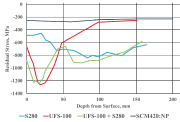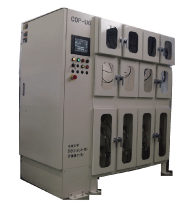Being the World Leader in metallic media, including W Abrasives’ Steel shot and grit, cut wire and stainless abrasives, Winoa is proud to offer to its customers value-added products, services and solutions for their peening, cleaning and surface preparation applications.
Far beyond playing the simple role of a commodity supplier, Winoa is always willing to team up with its customers in order to progress toward excellence. In order to meet the stringent requirements of the peening industry, W Abrasives has innovated in new media, tools and services.
MFN had the opportunity to meet with YAMADA Yoshikazu and ANDO Masafumi, Product and Test Center manager at IKK Shot Co. – Winoa’s Asian division, to discuss the challenges of tomorrow in surface preparation and peening.
(?) MFN: Hello YAMADA Yoshikazu (Y.Y.) and Ando san (A.M.) We all know that technologies are improving, techniques are evolving, and major changes are taking place in the field of transportation. What are the impacts of these changes concerning surface preparation and peening?
(!) Y. Y.: Challenges in various industries have already begun towards a carbon-free society, especially the automobile industry. The trend to shift from gasoline-powered vehicles to hybrid and electric vehicles, including fuel cell, is accelerating.
Sales of new gasoline-powered vehicle are predicted to be banned in Japan by the mid-2030s, similarly globally. This trend will have a direct impact on shot peening and blasting needs.
Conventional engines, heavy-duty casted steel parts and weight-heavy power trains are expected to decline.
On the other hand, for large vehicles such as trucks, construction machinery or aircraft and ships, further improvement in fuel efficiency is required, hence the need to reduce the weight of parts. It is therefore expected that such needs will arise for parts which have not required shot peening in the past.
(?) MFN: With these changes, what are the challenges manufacturers are now facing?
(!) Y. Y.: As mentioned previously, the global demand for peening will decline as a whole. In such circumstances, I think, just like at Winoa, that it is necessary to develop new markets and technologies, to find better ways of doing things and to create new products and services. For example, using shot peening to reduce friction - we call this COP, using a UFS product (ultra-fine shot). This is an industry-academia joint project with our group company Itoh Kikoh and Meijo University.
(?) MFN: What are some services where Winoa and your team can help to develop these new solutions?
(!) Y. Y.: We have several technical centers within our group to develop these new technologies and solutions. For example, we have various projects on different test machines, in partnership either with customers and/or research centers to find new solutions, either in France, Brazil or Japan. If we take Japan, we have this COP system with which we are testing different processes of using UFS (Ultra Fine Shots) for development of new market demand. In addition, as a solution provider, the Winoa Group listens to customer issues, identifies areas for improvement after extensive machine and on-site process checks, then presents solutions and countermeasures and full implementation support.
(?) MFN: Can you tell me more about UFS?
(!) Y. Y.: UFS (Ultra Fine Shot) is a steel-based material with a size variation of 50 to 250 μm. (Fig.1, Table1)
It is mainly used to improve the fatigue strength of automobile parts such as gears, shafts, and springs (Fig. 2). The main advantage is that it can apply high compressive residual stress to the surface layer compared to normal size peening. The effect is high compared to the distribution of compressive residual stress by normal size shot peening, UFS peening and composite peening as shown in Fig.3, and with the effect of shot peening being to increase the hardness of the surface due to plastic deformation of the material, the surface hardness increases from about 100HV to 150HV by shot peening, which contributes to wear and fatigue resistance.
In addition, since the starting point of fracture generally comes from the surface profile and topology, using UFS can make a surface smoother and improve the effectiveness of the peening process.
(?) MFN: We all know about ceramic media for fine peening, but what are the advantages of UFS versus this media?
(!) Y. Y.: The requirements for improving fatigue resistance of shot-peened parts is to obtain a high compressive residual stress and a fine surface roughness. Since ceramic media has higher hardness due to its material composition, it is possible to use it to apply high compressive residual stress on parts. But on the other hand, because it is a brittle material, it is highly aggressive to an object, forming a coarser surface than the same-sized UFS. As for the UFS, which is a steel media, it also has high hardness but undergoes some plastic deformation, so the residual compressive stress can be effectively applied to the surface without creating important roughness on the shot-peened surface. In Japan, ceramic media is rarely used for peening gears that can be affected by surface fracturing, so steel media is used as the main shot-peening solution.
(?) MFN: Where else can the UFS be used?
(!) A. M.: A new application has recently been developed. It is possible to form an appropriate micro dimple to reduce friction. Conventionally, there are techniques and devices that projects UFS to create these surfaces. But there is a drawback: it is difficult to control the amount of dimple coverage due to the very fine particle size used. But the "COP system" technology that we jointly developed with Itoh Kikoh and Meijo University, was able to solve this (Fig.4). COP stands for “Coverage Optimized Peening” and “Condition Optimized Peening”. The former uses the COP System to control coverage and reduce friction by forming optimal micro dimples, and here, Fig. 5 shows the surface condition of the material on which the UFS was projected using that technology. The latter is a surface modification method that does not necessarily depend on compressive residual stress, which is an important factor in conventional shot peening. Concretely, the UFS acts as a hammer and coats the surface of the material with functional particles, with this situation being shown in Fig. 6. This specific application is applied in the fields of bearings, molds, and cutting tools.
(?) MFN: Yamada san previously mentioned that Winoa offers technical support and testing. Ando san, with the Covid situation, how have you adapted?
(!) A. M.: Our technical teams, what we call our “Walue” team, have always remained available since the outbreak began. Virtual and remote technical support and training have taken place all over the world. We even recently developed, at group level, a comprehensive virtual training program for our customers.
(?) MFN: What are the benefits and impacts of these services on your customers?
(!) A. M.: It is certain that, even during this Covid period, our customers seek to lower their surface preparation costs. Our teams have succeeded, in working jointly with our customers either virtually or in person while respecting sanitary rules, in improving the shot peening or blasting processes. The benefits are numerous, for both our customers and us. An improved cleaning process for our customers means lower rejections, and shorter blasting cycles end up with better sales! For us, these new services allow us to be present and closer to our customers, helping them to prepare for “tomorrow's surfaces”...
MFN would like to thank YAMADA
Yoshikazu and ANDO Masafumi for their time and this interview!
For Information: Winoa
528 Avenue de Savoie
38570 Le Cheylas, France
Tel. +33.682.300-1885
E-mail: iann.bouchard@wabrasives.com
Yoshikazu YAMADA
Asia Product Management & Test Center
IKK SHOT CO., LTD.
Tel. +81.52.307-8166
E-mail: yoshikazu.yamada@ikkshot.com
www.winoagroup.com
www.wabrasives.com






































